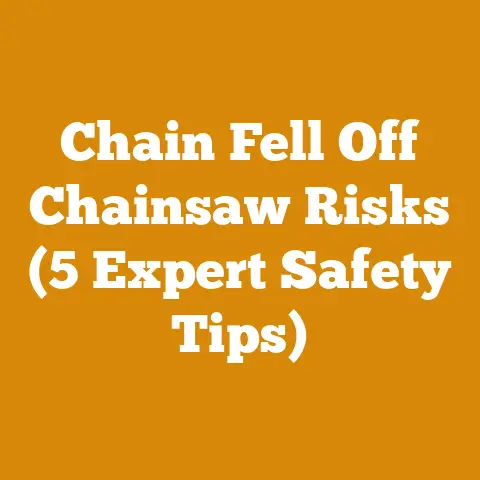Average Cost to Cut Down a Large Tree (5 Expert Tips to Save)
Ever wondered what it truly costs to remove that towering giant in your backyard?
The answer, as I’ve learned from years of experience in the field, isn’t always straightforward.
Let’s dive into the real costs of tree removal and, more importantly, how you can save money without compromising safety or quality.
Average Cost to Cut Down a Large Tree: 5 Expert Tips to Save
Cutting down a large tree is a significant undertaking, and understanding the costs involved is crucial.
The price can vary widely depending on several factors, but let’s break it down and explore some proven strategies to keep your expenses in check.
Understanding the Baseline Costs
The average cost to cut down a large tree typically ranges from $750 to $2,500.
This broad range reflects the many variables at play, including the tree’s size, location, condition, and the complexity of the removal process.
In my experience, I’ve seen prices fluctuate even more dramatically when specialized equipment or hazardous conditions are involved.
- Size Matters: Taller and wider trees require more labor and equipment, naturally increasing the cost.
- Location, Location, Location: Trees near power lines, buildings, or other obstacles pose additional risks, necessitating specialized techniques and higher insurance costs for the tree service.
- Condition of the Tree: Diseased or unstable trees are more dangerous to remove, adding to the complexity and cost.
Tip #1: Get Multiple Quotes
This might seem obvious, but it’s the most crucial step.
Don’t settle for the first estimate you receive.
I always recommend getting at least three quotes from different tree service companies.
This allows you to compare pricing, services offered, and the overall professionalism of each company.
- Why it Works: Each company has its own overhead costs, pricing structures, and assessment of risk.
By comparing quotes, you can identify the most competitive and reasonable price for your specific situation. - My Experience: I once saved a client over $800 simply by helping them get three different quotes.
The initial estimate was inflated due to the perceived difficulty of the job, which other companies assessed more realistically. - Actionable Step: Use online directories like Angie’s List, HomeAdvisor, or even local community groups on Facebook to find reputable tree service companies in your area.
Tip #2: Understand the Scope of the Quote
Not all quotes are created equal.
It’s essential to understand exactly what is included in the price.
A low initial quote might seem attractive, but it could exclude crucial services like stump removal, debris cleanup, or necessary permits.
- What to Look For: Ensure the quote clearly outlines all services, including:
- Tree removal
- Stump grinding or removal
- Debris removal (branches, logs, etc.)
- Permit fees (if required by your local municipality)
- Insurance coverage (liability and worker’s compensation)
- Example: I’ve seen cases where a homeowner was quoted a low price for tree removal, only to be hit with additional charges for stump grinding and debris cleanup, effectively doubling the initial estimate.
- Pro Tip: Ask for a detailed, written quote that breaks down each cost component.
This helps you avoid any surprises down the line.
Tip #3: Consider Off-Season Removal
Tree service companies are often busiest during the spring and summer months.
Demand is high, and prices tend to reflect that.
Consider scheduling your tree removal during the off-season (late fall or winter) when demand is lower.
- Why it Works: During the off-season, tree service companies are often looking to fill their schedules and may offer discounted rates to attract customers.
- My Experience: I once helped a neighbor save 20% on a large tree removal by scheduling it in late November.
The company was eager to secure the work before the winter slowdown. - Caveat: Be mindful of weather conditions.
Extreme cold or heavy snow can make the job more difficult and potentially increase the cost.
Tip #4: DIY (If You’re Qualified and Equipped)
This is a big one, and I want to preface it with a serious warning: tree removal can be extremely dangerous.
If you’re not experienced with chainsaws, climbing, and rigging, or if the tree is particularly large or located near hazards, do not attempt to remove it yourself.
However, if you have the skills, experience, and proper equipment, DIY tree removal can save you a significant amount of money.
- Essential Equipment:
- Chainsaw: A professional-grade chainsaw with a sharp chain is essential.
I personally use a Stihl MS 462 for most large tree removals.- Specifications: 70cc engine, 20-inch bar, weight around 15 lbs.
- Safety Gear: Helmet, eye protection, ear protection, gloves, chainsaw chaps, and steel-toed boots are non-negotiable.
- Climbing Gear: Harness, ropes, carabiners, and climbing spurs if you need to climb the tree.
- Wedges and Felling Axes: To help direct the fall of the tree.
- Log Splitter: To process the wood after the tree is down.
I recommend a gas-powered log splitter with at least 25 tons of splitting force.- Example: A 27-ton gas log splitter from brands like Champion or Huskee.
- Chainsaw: A professional-grade chainsaw with a sharp chain is essential.
- Step-by-Step DIY Guide (Simplified):
- Assess the Tree: Identify any hazards (power lines, buildings, etc.) and plan your escape route.
- Limb Removal: Start by removing lower limbs to clear your work area.
- Notching: Cut a notch on the side of the tree in the direction you want it to fall.
The notch should be about 1/3 of the tree’s diameter. - Back Cut: Make a back cut on the opposite side of the tree, slightly above the notch.
Leave a hinge of wood to control the fall. - Felling: Use wedges if necessary to help direct the fall.
- Limbing and Bucking: Once the tree is down, remove the remaining limbs and cut the trunk into manageable sections.
- Stump Removal: This can be done manually with a stump grinder or by digging it out.
- My Experience: I grew up on a farm and learned to fell trees from a young age.
However, I’ve also had close calls and witnessed accidents.
I cannot stress enough the importance of safety and proper training. - Cost Savings: DIY tree removal can save you hundreds or even thousands of dollars, but it comes with significant risks.
Be honest about your abilities and don’t hesitate to hire a professional if you’re unsure.
Tip #5: Negotiate and Be Flexible
Don’t be afraid to negotiate with tree service companies.
They may be willing to lower their price if you can be flexible with the scheduling or offer to handle some of the cleanup yourself.
- Negotiation Tactics:
- Ask for a Discount: Simply asking for a discount can sometimes be effective.
- Offer to Handle Cleanup: If you’re willing to handle some of the debris removal, you might be able to negotiate a lower price.
- Be Flexible with Scheduling: Allowing the company to schedule the job at their convenience can sometimes result in a discount.
- Example: I once negotiated a lower price by offering to stack the cut firewood neatly on my property.
This saved the company time and labor, and they passed the savings on to me. - Important Note: While negotiating, don’t compromise on safety or quality.
Ensure the company is properly insured and has a good reputation.
Additional Cost Factors to Consider
Beyond the core factors, several other elements can influence the cost of tree removal:
- Emergency Services: Removing a tree that has fallen on a house or power line will be significantly more expensive due to the urgency and complexity of the situation.
- Permits: Many municipalities require permits for tree removal, especially for large or protected trees.
The cost of these permits can vary widely. - Travel Fees: If the tree service company has to travel a significant distance to reach your property, they may charge a travel fee.
- Specialized Equipment: If the tree is in a difficult location or requires specialized equipment like a crane, the cost will increase.
Case Studies and Real-World Examples
Let’s look at some real-world examples to illustrate how these factors can impact the cost of tree removal:
- Case Study 1: Large Oak Tree Near Power Lines
- Location: Residential property in a suburban area.
- Tree: 80-foot oak tree located near power lines.
- Challenges: Proximity to power lines required specialized equipment and experienced climbers.
- Cost: $3,500
- Savings: The homeowner obtained three quotes and negotiated a lower price by offering to handle some of the cleanup.
- Case Study 2: Diseased Maple Tree in Backyard
- Location: Residential property in a rural area.
- Tree: 60-foot maple tree with significant decay.
- Challenges: The tree was diseased and unstable, requiring careful removal to prevent damage to the surrounding property.
- Cost: $2,800
- Savings: The homeowner scheduled the removal during the off-season and saved 15%.
- Case Study 3: DIY Tree Removal (Small Pine Tree)
- Location: Residential property in a rural area.
- Tree: 30-foot pine tree located away from any structures or power lines.
- Challenges: None.
The homeowner had experience with chainsaws and tree felling. - Cost: $200 (cost of fuel, chain sharpening, and safety gear)
- Savings: The homeowner saved approximately $800 by removing the tree themselves.
Common Mistakes to Avoid
- Hiring Uninsured Contractors: Always verify that the tree service company has adequate liability and worker’s compensation insurance.
This protects you from financial liability if someone is injured or property is damaged during the removal process. - Ignoring Permits: Failing to obtain necessary permits can result in fines and delays.
Check with your local municipality to determine if a permit is required. - Compromising on Safety: Don’t choose a tree service company solely based on price.
Safety should be your top priority. - Neglecting Stump Removal: Leaving a stump can be unsightly and attract pests.
Consider stump grinding or removal to complete the job. - Not Planning for Debris Disposal: Determine how you will dispose of the tree debris before the job begins.
Some companies include debris removal in their quote, while others charge extra.
The Importance of Proper Equipment
Whether you’re hiring a professional or tackling the job yourself, having the right equipment is crucial.
Let’s delve deeper into the essential tools for tree removal and processing:
- Chainsaws:
- Types: Gas-powered, electric, and battery-powered.
Gas-powered chainsaws are generally preferred for larger trees due to their power and portability. - Bar Length: Choose a bar length that is appropriate for the size of the tree.
A longer bar is needed for larger trees. - Maintenance: Regular chain sharpening, air filter cleaning, and spark plug replacement are essential for optimal performance and safety.
- Types: Gas-powered, electric, and battery-powered.
- Log Splitters:
- Types: Gas-powered, electric, and manual.
Gas-powered log splitters are the most powerful and efficient for splitting large quantities of wood. - Tonnage: Choose a log splitter with sufficient tonnage for the type of wood you’re splitting.
Hardwoods like oak and maple require more tonnage than softwoods like pine. - Safety Features: Look for log splitters with safety features like two-handed operation and automatic shut-off.
- Types: Gas-powered, electric, and manual.
- Safety Gear:
- Helmet: Protects your head from falling branches and debris.
- Eye Protection: Prevents wood chips and debris from entering your eyes.
- Ear Protection: Reduces the risk of hearing damage from chainsaw noise.
- Gloves: Provides a better grip and protects your hands from cuts and abrasions.
- Chainsaw Chaps: Protects your legs from chainsaw cuts.
- Steel-Toed Boots: Protects your feet from falling logs and sharp objects.
- Climbing Gear:
- Harness: Distributes weight evenly and prevents falls.
- Ropes: Used for climbing and rigging.
- Carabiners: Used to connect ropes and harnesses.
- Climbing Spurs: Used to climb trees with thick bark.
- Other Essential Tools:
- Wedges: Used to help direct the fall of the tree.
- Felling Axes: Used to fell trees and split wood.
- Sledgehammers: Used to drive wedges.
- Measuring Tape: Used to measure tree diameter and cut wood to the desired length.
- First Aid Kit: Essential for treating minor injuries.
Wood Processing Techniques
Once the tree is down, you’ll need to process the wood.
Here are some common techniques:
- Limbing: Removing the branches from the trunk.
- Bucking: Cutting the trunk into manageable sections.
- Splitting: Splitting the wood into smaller pieces for firewood.
- Stacking: Stacking the firewood in a way that allows for proper air circulation.
- Drying: Allowing the firewood to dry for several months before burning.
Timber Grading and Sawmill Operations
If you’re dealing with a large quantity of wood, you might consider having it milled into lumber.
This requires understanding timber grading and sawmill operations:
- Timber Grading: The process of evaluating the quality and value of timber based on factors like size, species, and defects.
- Sawmill Operations: The process of converting logs into lumber using a sawmill.
This involves sawing, edging, and trimming the wood to the desired dimensions.
Firewood Preparation and Drying
If you plan to use the wood for firewood, proper preparation and drying are essential:
- Splitting Techniques:
- Manual Splitting: Using a splitting axe or maul to split the wood.
- Mechanical Splitting: Using a log splitter to split the wood.
- Drying Process:
- Air Drying: Stacking the firewood in a well-ventilated area for several months.
- Kiln Drying: Drying the firewood in a kiln to reduce the moisture content more quickly.
- Moisture Content Targets: Aim for a moisture content of 20% or less for optimal burning.
Safety Procedures and Best Practices
Safety should always be your top priority when working with trees and wood.
Here are some essential safety procedures and best practices:
- Wear appropriate safety gear at all times.
- Inspect your equipment before each use.
- Be aware of your surroundings and potential hazards.
- Never work alone.
- Take frequent breaks to avoid fatigue.
- Know your limits and don’t attempt tasks that are beyond your abilities.
- Attend a chainsaw safety course to learn proper techniques.
- Follow all manufacturer’s instructions for your equipment.
- Have a first aid kit readily available.
- In case of an emergency, know how to contact emergency services.
Actionable Metrics for Success
To measure your success in wood processing and firewood preparation, consider these actionable metrics:
- Processing Time: Track the time it takes you to process a certain quantity of wood.
- Moisture Content: Regularly measure the moisture content of your firewood to ensure it’s properly dried.
- Equipment Maintenance Schedule: Create a schedule for maintaining your equipment to ensure it’s always in good working condition.
- Safety Record: Track any incidents or injuries that occur during wood processing or firewood preparation.
Challenges and Contexts for Small-Scale Loggers
Small-scale loggers face unique challenges, including:
- Limited Resources: Access to capital, equipment, and training may be limited.
- Market Access: Finding buyers for their timber or firewood can be difficult.
- Regulatory Compliance: Navigating complex regulations and permitting requirements can be challenging.
- Safety Concerns: Working in remote locations with limited access to emergency services.
Final Thoughts
Cutting down a large tree can be a costly endeavor, but by following these expert tips, you can save money without compromising safety or quality.
Remember to get multiple quotes, understand the scope of the quote, consider off-season removal, DIY if you’re qualified and equipped, and negotiate and be flexible.
Always prioritize safety and ensure you have the right equipment and knowledge to complete the job successfully.
Remember, my experiences in the field have taught me that preparation and knowledge are your best tools.
Take the time to educate yourself, assess the risks, and make informed decisions.
And when in doubt, don’t hesitate to call in a professional.
Your safety and the well-being of your property are always worth the investment.






